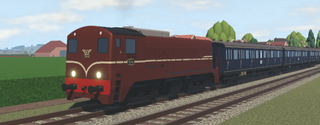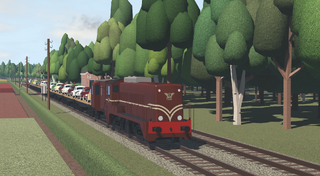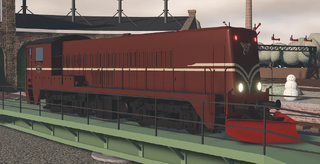| NS 2200 | |
|---|---|
| by Supersnel11 | |
| Price | ƒ195.000 |
| Level | 49 |
| Statistics | |
| Type | Mixed |
| Top Speed | 106 km/h |
| Weight | 72 tons |
| Capacity | 640 tons |
| Passenger Capacity | 2 first class 2 second class |
| Length | 13,9 meters |
The NS 2200 was a series of 150 Dutch Bo'Bo' (Two bogies, each with four driven wheels) diesel-electric locomotive. They are based on an American design.
Variants
The NS 2200 is available in three liveries: Standard, Triple Headlight and Exhaust Muffler. It received snow plough liveries in the winter updates based on the standard livery.
Historical detail
NS years
In the early 1950s, the Nederlandsche Spoorwegen (NS) made the decision that their remaining steam locomotives had to be withdrawn in the next few years. To replace them, 280 diesel-electric locomotives were ordered, divided over the NS 2200 and NS 2400 series.
The Hengelosche Electrische en Mechanische Apparaten Fabriek (Heemaf) ordered to deliver 100 locomotives based on Balwin's RS-448E in October of 1952. NS accepts the offer a month later, though the definitive design wasn't actualised until 1953. They would cost NS ƒ500.000,- a piece. Heemaf produced the electrical installation themselves, but had Allan & Co´s Koninklijke Nederlandsche Fabrieken van Meubelen en Spoorwegmaterieel N.V. (Allan) produce the mechanical parts and Stork to produce the diesel motors. NS 2201 would do its trial run on December 13th, 1954. In 1955, NS requested that an additional 50 locomotives be built. Because of a cooperation treaty with France, Heemaf allowed Creusot-Loire to build the mechanical parts and Jeumont-Schneider to build the electrical parts, under license.
NS 2201 would enter service in January, 1955 at Eindhoven depot. The main job of the class was to pull coal trains in the South of the Netherlands on the not yet electrified tracks. At the end of February, the 2201-2203 were moved to depot Watergraafsmeer for goods traffic.
In early June, 1955, they would be used on their first passenger trains, between Alkmaar and Hoorn. In 1957 they would replace DMUs with a luggage van and Plan E coaches on the trains Alkmaar-Den Helder, though they would lose this job a year later with the completion of the electrification of the line. In 1958 they would take over some passenger trains from the NS 2000.

Between 1961-1964, they would pull trains with large stones used to expand the harbour at IJmuiden. Two 2200s would multi-unit the train from Roosendaal to depot Lage Zwaluwen, from where the train would go either IJmuiden or the royal Dutch blast furnaces. Trains to the blast furnaces would get a third 2200 at the back of the train so the train could be split up and actually fit in the yard of the blast furnaces.
The 2.400 ton ore trains Amsterdam-Emmerich would be pulled by three 2200s driving multiple-unit. In 1968 a trial was held with 3.000 ton trains pulled by four 2200s, which had no trouble with the train. An electric Baureihe 150 would take over in Emmerich.
Starting in 1968, the series lost their brown livery and got painted in the newly introduced yellow-grey style.
Between 1971-2003, less and less work would be available for the class. In the same time, a majority of the class was scrapped. The 2279, 2248 & 2218 were withdrawn and scrapped after accidents in 1972, 1974 & 1981 respectively. Between 1985-1995, all but five had been put out of service. These would work at NS Cargo (later Railion, even later DB Cargo). In 2003, Railion withdrew the last 2003. The 2225, 2278 and 2368 would be preserved.
Post-NS years
NMBS
In 1995, 25 2200s were sold to the Belgian railways (NMBS) which used them to construct the high speed lines and for work in harbours. They were renumbered 7601-7625 but became obsolete in 2002, with the introduction of the NMBS 77 series. All but two, 2205 & 2275, were scrapped. The surviving locomotives returned to the Netherlands for heritage use.
Strukton
Three machines, 2270, 2282 & 2328, were sold to railway contractor Strukton. Struktok added '30' infront of all the numbers and named them Berta, Anneke and José respectively. They were all painted in Strukton's yellow livery during a revision, which practically changed everything but the frame and a part of the cab.
In 2007, the locomotives were rented to Eurailscout Inspection & Analysis b.v., which used them to inspect railways and renumbered them. After returning to Strukton, they were withdrawin in 2010, 2021 and 2015.
Heritage
Eleven 2200s have been preserved at various foundations and heritage railways:
| Number(s) | Owned by | Operational | Notes | |
|---|---|---|---|---|
| 2203 | Veluwsche Stoomtrein Maatschappij (VSM) | No | ||
| 2205 | NMBS 7618 | Stichting Historisch Dieselmaterieel (SHD) | Yes | Yellow-grey livery |
| 2207 | VSM | No | ||
| 2215 | Zuid-Limburgse Stoomtrein Maatschappij (ZLSM) | Yes | On loan from the Dutch railway museum (NSM); yellow-grey livery | |
| 2225 | Stichting Museum Materieel Railion (SMMR) | Yes | ||
| 2233 | VSM | Yes | ||
| 2264 | Nederlands Spoorweg Museum (NSM) | No | Yellow-grey livery | |
| 2275 | NMBS 7608 | SHD | No | |
| 2278 | Stichting Stadskanaal Rail (STAR) | Yes | Purchased from SMMR; yellow-grey livery | |
| 2282 | Strukton 302282 | SHD | Unknown | |
| 2296 | NS 2368 | 2454CREW | No | Purchased from Stichting Erfgoed Hengelo; yellow-grey livery |
| 2299 | VSM | No | ||
Technical detail
The NS 2200 are 14,01 metres long and weigh 72 tons with an axle load of 18 tons. They were originally equipped with: a Stork type 40C-LX-8 motor (if produced in the Netherlands) or a Schneider 8-cylinder, 900 horsepower engine (if produced in France); a Heemaf type GMT 110 main generator providing 550 kVA, 1300A at 1100 RPM (750 horsepower); a Heemaf type GM 20-32 motor generator with a contineous power of 11.4 kVA, 38 A at 2260 RPM; four Heemaf type TM 98 traction engines with a contineous power of 184 kW, 680 A at 550 RPM. Additionally they had Westinghouse & Henry brakes.
In 1957 onwards they were fitted with Oerlikon brake valves. In 1963 they were fitted with ATB, a by now outdated Dutch train security system.
They were capable of reaching a speed of 106 km/h but were set to a maximum speed of 100.
The wheels have a diameter of 95 mm.
The cab was only accessible through one door; the other door provided access to the walk-around of the engine hood. The engine hood was divided in to three parts, each with its own doors on the side and a hatch on the roof. The front-most part housed the ventilator and air tank, the middle part housed the engine and the part closest to the cab housed the generator.
They were forbidden from passing curves with a diameter of 90 metres or smaller on their own, 80 with a train.
Trivia
- The NS 2200 has a capacity only beaten by the NS 4900 and the NS 3950.
- The Standard and Triple Headlight liveries share the sounds with the Exhaust Muffler livery since no unmuffled sounds exist/are available.
- The NS 2200 is the only locomotive to have received a snow plow livery in every winter update.
- The NS 2200 has been available since launch, only in the Standard livery.
- The Triple Headlight and Exhaust Muffler liveries was added in 0.4.61.
Gallery
-
NS 2314 pulls a set of C12c coaches along the countryside.
-
NS 2226 carries a load of brand new cars to the harbour for export.
-
The NS 2200 Plow livery






